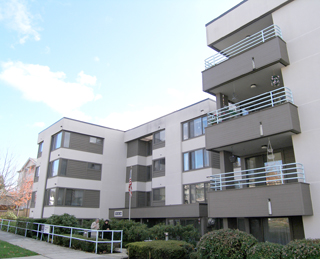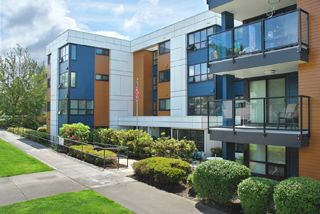|
Subscribe / Renew |
|
|
Contact Us |
|
| ► Subscribe to our Free Weekly Newsletter | |
| home | Welcome, sign in or click here to subscribe. | login |
Environment
| |
 |
February 17, 2011
Public housing gets a green makeover
GGLO

Hartwell
|
Seattle Housing Authority is taking advantage of the current slower construction market to improve the energy efficiency of several buildings in its senior housing portfolio.
The goals of the renovations are to improve energy efficiency and increase water penetration resistance through the use of proven building enclosure technologies. Doing so will greatly extend the useful life of the structures, reduce long-term operating costs and keep affordable units online.
Additionally, SHA strives to create buildings that are “good neighbors,” contributing to the fabric of their communities through thoughtful architectural design and color palettes, and sustainable building practices.
Built as turnkey projects in the early 1980s, many of the portfolio properties were constructed using face-sealed stucco finishes and double-pane aluminum windows. Today they suffer from moderate to severe water damage and window failure.
To date, seven of the most problematic buildings have undergone exterior redesigns using rainscreen siding strategies and air-tightness improvements. Three of these have recently completed construction. The renovations utilize Washington’s Evergreen Sustainable Development Standards (ESDS) criteria and are expected to perform significantly better.
Meeting green goals
The senior housing portfolio properties lie within Seattle’s city limits and often figure prominently in their neighborhoods.
For example, Nelson Manor sits across the street from Ballard Commons Park, Olmsted Manor faces the lush greenery of Northeast Ravenna Boulevard, and Bitter Lake Manor overlooks the adjacent Bitter Lake Park. Reunion House lies a block east of Capitol Hill’s bustling Broadway shopping district, and Willis House is within walking distance to Green Lake.
These properties all meet the ESDS “walkable neighborhoods” criteria, with locations next to amenities and public transportation.
In 2007, SHA hired RDH Building Sciences to conduct building enclosure condition assessments of these properties. Each was assessed and prioritized based on the extent of its enclosure deficiencies.
It soon became clear that due to the amount of moisture damage observed, several buildings would require complete enclosure rehabilitation. RDH, teamed with GGLO, set about redesigning and updating those most severely damaged.
In 2009, Ballard’s Schwabacher House rehabilitation was completed, followed by the renovations of Reunion House and Willis House in early 2010. Last December, SHA was awarded $3 million from Seattle’s Office of Housing. These funds will be applied to four more renovations scheduled for completion in the next 20 to 24 months: Olmsted Manor, Nelson Manor, Bitter Lake Manor and Blakeley Manor in the University District.
The inclusion of ESDS criteria affected the design ideas and construction documentation process as it steered the team to generate sustainable solutions that stayed within budget. Upgrades previously integrated by SHA, such as installing Energy Star appliances and lighting fixtures in common areas, received credit retroactively, thus helping each renovation meet ESDS goals.
Keeping drafts at bay
The key to improving the buildings’ thermal, air tightness and moisture performance has been the use of rainscreen siding assemblies.
In each case, the original stucco siding and sheathing layers are removed, damaged framing is replaced with Forest Stewardship Council-certified lumber, and any water-damaged batt insulation is replaced with blown-in cellulose insulation.
The new exterior siding, typically cementitious panel or lap, is applied over 2-by-4 pressure-treated rainscreen furring over new sheathing, creating a gap between the siding and sheathing to allow rain to drain away from the building.
To combat air infiltration, a seamless liquid air- and weather-resistive barrier is applied to the sheathing, with improved transitions through windows and other building enclosure penetrations. To improve energy efficiency, a layer of exterior R-5 mineral wool insulation is applied within the cavity between the sheathing and siding.
The aluminum windows are replaced with double-glazed insulated vinyl windows with a U-value of 0.29. All exhaust vents are replaced and sealed. Improving the air-tightness of the buildings improves residents’ comfort by reducing drafts and sound transmission, and ultimately lowers utility costs for SHA and its residents.
Comfort for residents
The trend to renovate and provide energy- and water-efficient upgrades is proving a cost-effective strategy for SHA, which currently has 994 residential units in 23 senior housing buildings.
SHA has been installing low-flow plumbing fixtures and fittings and energy-efficient CFL and LED light fixtures throughout its properties concurrent with remodels. Bath fans are routinely replaced with Energy Star-rated models. Durability is also a key factor, and SHA’s investment in higher-quality products will reduce future maintenance costs.
Although the buildings are continuously occupied during construction, residents have responded positively to their new surroundings following completion. In post-construction evaluation reports of Schwabacher House, residents said the inconvenience of daily construction for eight months was worthwhile for the “beautiful building” in which they now live.
Many reported liking their air-tight windows and new solid-surface sills. Others delighted in living in a building “that looks like an expensive condominium.”
Many found they no longer needed air conditioners because their units are better insulated, have reduced air leakage and are more thermally stable with efficient windows.
A large part of the continued energy savings potential lies with tenant education, according to Roxanne Navrides, a construction project manager for SHA.
“Resident education happens at the beginning of the process with pre-construction meetings, and continues afterwards with post-construction Q-and-A sessions and information distribution for new equipment,” she said.
All renovations also use a centralized bulletin board to update residents on construction schedules and a telephone hot line for questions or concerns.
SHA tracks utility use at its buildings, as does the Office of Housing’s HomeWise program, which provides rebates for energy conservation measures based on kilowatt-hours saved.
Partnership opportunities with Seattle City Light and Seattle Public Utilities are being investigated to monitor cost/benefit analyses. Renewable solar energy options are now being tested at South Shore Court, where solar panel collection units provide preheated water for two residential units and its common laundry facilities. Seattle City Light is tracking the differences in consumption between the two types of units.
SHA is in the process of reviewing its high-rise public housing buildings to determine candidates for solar water heating systems.
With a team-oriented approach dedicated to innovation and social commitment, Seattle Housing Authority shows that energy efficient, low-cost renovation work does not require sacrificing aesthetic appeal, design versatility or resident satisfaction.
Amy Hartwell is a project architect at GGLO, where her experience with multifamily, mixed-use, and rehabilitation projects encompasses the full spectrum of design development.
Other Stories:
- Watch out for 'greenwashing' by service providers
- EcoDistricts: Sustainability that goes beyond buildings
- Rethinking the big-box store: Housing? Restaurants? Farms?
- Sustainable developments reach Puget Sound shores
- Green is catching on in the real estate industry
- City's role evolving as green practices take hold
- Yes, parking lots can be green
- Sustainable housing a natural fit for Bastyr
- 2 Seattle projects set ‘net-zero’ water goals
- Living Building project meant sweating the details




